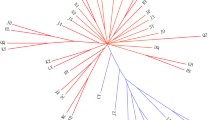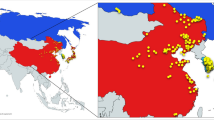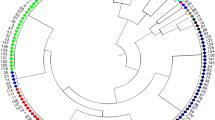Abstract
Wild soybean individuals were sampled from ten habitat sites in Beijing region, China and were assessed using 36 SSR markers for the genetic variation among the habitat subpopulations. AMOVA analysis showed 57.46 % inter-population and 42.54 % intrapopulation genetic variation. The genetic variation had geographical regionality. The drought-stressed and founder subpopulations intensively reduced genetic diversity, and along-river system habitats appeared to have closer genetic similarity. The bottleneck impact of drought stress appeared to be inferior to the founding effect on subpopulation genetic diversity but superior on genetically geographical grouping. Here, all the subpopulations were found to contain unique alleles. The phenotypic and genetic diversities had similarly fluctuated patterns across the subpopulations. These results here suggest that a conservation strategy should be taken: theoretically as many as possible populations are sampled to maximize the genetic diversity in ex situ conservation of wild soybean within an area in China. Spatial distance should be considered for isolating wild soybean populations when genetically modified soybeans are cultivated in China.






Similar content being viewed by others
References
Abe J, Hasegawa A, Fukushi H, Mikami T, Ohara M, Shimamoto Y (1999) Introgression between wild and cultivated soybean of Japan revealed by RFLP analysis for chloroplast DNA. Econ Bot 53:285–291
Broich SL, Palmer RG (1980) A cluster analysis of wild and domesticated soybean phenotypes. Euphytica 29:23–32
Cain ML, Milligan BG, Sterand AE (2000) Long-distance seed dispersal in plant populations. Am J Bot 87:1117–1227
Chen X, Yan JY, Gao B (2004) Preliminary study on roundup ready soybean’s round-up ready gene move to wild soybean. Chinese J Oil Crop Sci 26(2):89–91
Choi IY, Kang JH, Song HS, Kim NS (1999) Genetic diversity measured by simple sequence repeat variations among the wild soybean, Glycine soja, collected along the riverside of five major rivers in Korea. Genes Genet Syst 74:169–177
Close PS, Shoemaker RC, Keim P (1989) Distribution of restriction site polymorphism within the chloroplast genome of the genus Glycine, subgenus Soja. Theor Appl Genet 77:768–776
Cregan PB, Jarvik T, Bush AL, Shoemaker RC, Lark KG, Kahler AL, Kaya N, Vantoai TT, Lohnes DG, Chung J, Specht JE (1999) An integrated genetic linkage map of the soybean genome. Crop Sci 39:1464–1490
Dong YS, Zhuang BC, Zhao LM, Sun H, He MY (2001) The genetic diversity of annual wild soybean grown in China. Theor Appl Genet 103:98–103
Excoffier L, Laval G, Schneider S (2005) Arlequin ver. 3.0: An integrated software package for population genetics data analysis. Evol Bioinform Online 1:47–50
Felsenstein J (1993) PHYLIP (Phylogeny inference package) version 3.5c. University of Washington Press, Seattle
Fu YL, Qian J, Ma YH, Li J, Zheng SZ (2002) Genetic differentiation research on populations of wild soybeans in different scales. (China). Acta Ecol Sin 22:176–184
Fujita R, Ohara M, Okazaki K, Shimamoto Y (1997) The extent of natural cross-pollination in wild soybean (Glycine soja). J Hered 88:124–128
Fukuda Y (1933) Cytogenetical studies on the wild and cultivated Manchurian soybeans (Glycine L.). Japan J Bot 6:489–506
Hermann FJ (1962) A revision of the genus Glycine and its immediate allies. USDA Tech Bull 1268:1–79
Hu ZA, Wang HX (1985) Genetic structure of natural population of wild soybean (Glycine soja) on the Beijing region. (China). Acta Bot Sin 27:599–604
Hymowitz Y (1970) On the domestication of the soybean. Econ Bot 24:408–421
Hyten DL, Song QJ, Zhu YL, Choi IY, Nelson RL, Costa JM, Specht JE, Shoemaker RC, Cregan PB (2006) Impacts of genetic bottlenecks on soybean genome diversity. Proc Natl Acad Sci USA 103:16666–16671
Jin Y, Zhang WJ, Fu DX, Lu BR (2003a) Sampling strategy within a wild soybean population based on its genetic variation detected by ISSR markers. (China). Acta Bot Sin 45:995–1002
Jin Y, He TH, Lu BR (2003b) Fine scale genetic structure in a wild soybean (Glycine soja) population and the implication for conservation. New Phytol 159:513–519
Kiang YT, Chiang YC, Kaizuma N (1992) Genetic diversity in natural populations of wild soybean in iwate prefecture, Japan. J Hered 83:325–329
Kuroda Y, Kaga A, Tomooka N, Vaughan DA (2006) Population genetic structure of Japanese wild soybean (Glycine soja) based on microsatellite variation. Mol Ecol 15:959–974
Kuroda Y, Kaga A, Tomooka N, Vaughan D (2010) The origin and fate of morphological intermediates between wild and cultivated soybeans in their natural habitats in Japan. Mol Ecol 19:2346–2360
Li J, Tao Y, Zheng SZ, Zhou JL (1995) Isozymatic differentiation in local population of Glycine soja Sieb. & Zucc. (China). Acta Bot Sin 37:669–676
Liu K, Muse SV (2005) PowerMarker: Intergrated analysis environment for genetic marker data. Bioinformatics 21:2128–2129
Liu BH, Fujita T, Yan ZH, Sakamoto S, Xu DH, Abe J (2007) QTL mapping of domestication-related traits in soybean (Glycine max). Ann Bot 100:1027–1038
Liu J, Zhou B, Yang CY, Li YR, Jiang LX, Zhang MC, Tao B, Qiu LJ (2012) Gene flowing of genetically modified glyphosate-resistant soybean with EPSP. Soybean Sci 31:517–521
Loveless MD, Hamrick JK (1984) Ecological determinants of genetic structure in plant populations. Annu Rev Ecol Syst 15:65–95
Mizuguti A, Yoshimura Y, Matsuo K (2009) Flowering phenologies and natural hybridization of genetically modified and wild soybeans under field conditions. Weed Biol Manage 9:93–96
Mizuguti A, Ohigashi K, Yoshimura Y, Kaga A, Kuroda Y, Matsuo K (2010) Hybridization between GM soybean (Glycine max (L.) Merr.) and wild soybean (Glycine soja Sieb. et Zucc.) under field conditions in Japapn. Environ Biosafety Res 9:13–23
Morrell PL, Lundy KE, Clegg MT (2003) Distinct geographic patterns of genetic diversity are maintained in wild barley (Hoedeum vulgare ssp. spontaneum) despite emigration. Proc Natl Acad Sci USA 100:10812–10817
Nakayama Y, Yamaguchi H (2002) Natural hybridization in wild soybean (Glycine max ssp. soja) by pollen flow from cultivated soybean (Glycine max ssp. max) in a designed population. Weed Biol Manage 2:25–30
Nei M (1973) Analysis of gene diversity in subdivide populations. Proc Natl Acad Sci USA 70:3321–3323
Nei M, Takezaki N (1983) Estimation of genetic distances and phylogenetic trees from DNA anlysis. Proc. 5th World Cong. Genet Appl Livstock Prod 21:405–412
Rohlf FJ (2000) NTSYS 2.1: Numerical Taxonomic and Multivariate Analysis System. Exeter Software. New York
Shannon CE, Weaver W (1949) The mathematical theory of communication. University of Illinois Press, Ubana
Shimamoto Y, Fukushi H, Abe J, Kanazawa A, Gai JY, Gao Z, Xu DH (1998) Genet Resour Crop Evol 45:433–439
Shoemaker RC, Hatfield PM, Palmer RG, Atherly AG (1986) Chloroplast DNA variation in the genus Glycine subgenus Soja. J Hered 77:26–30
Sisson HD, Brim CA, Levings CS (1978) III. Characterization of cytoplasmic diversity in soybeans by restriction endonuclease analysis. Crop Sci 18:991–996
Sjögren P, Wyöni PI (1994) Conservation genetics and detection of rare alleles in finite populations. Conserv Biol 8:267–270
Skvortzow BW (1927) The soybean-wild and cultivated in Eastern Asia. Proc Manchurian Res Soc Publ Ser A 22:1–8
Tozuka T, Fukushi H, Hirata T, Ohara M, Kanazawa A, Mikami T, Abe J, Shimamoto Y (1998) Composite and clinal distribution of Glycine soja in Japan revealed by RFLP analysis of mitochondria DNA. Theor Appl Genet 96:170–176
Wang KJ, Li XH (2011) Interspecific gene flow and the origin of semi-wild soybean revealed by capturing the natural occurrence of introgression between wild and cultivated soybean populations. Plant Breed 130:117–127
Wang KJ, Li XH (2012) Genetic characterization and gene flow in different geographical-distance neighbouring natural populations of wild soybean (Glycine soja) Sieb. & Zucc.) and implications for protection from GM soybeans. Euphytica 186:817–830
Wang KJ, Li XH (2013) Pollen dispersal of cultivated soybean (Glycine max) into wild soybean (G. soja) under natural conditions. Crop Sci 53:2497–2505
Wang KJ, Takahata Y (2007) Apreliminary comparative evaluation of genetic diversity between Chinese and Japanese wild soybean (Glycine soja) germplasm pools using SSR markers. Genet Resour Crop Evol 54:157–165
Wang B, Chang RZ, Tao L, Guan RX, Yan L, Zhang MH, Feng ZF, Qiu LJ (2003) Identification of SSR primer numbers for analyzing genetic diversity of Chinaese cultivated soybean. (China). Mol Plant Breed 1:82–88
Wang KJ, Li XH, Zhang JJ, Chen H, Zhang ZL, Yu GD (2010) Natural introgression from cultivated soybean (Glycine max) into wild soybean (Glycine soja) with the implications for origin of populations of semi-wild type and for biosafety of wild species in China. Genet Resour Crop Evol 57:747–761
We ZX, Ding YL, Zhao TJ, Gai JY (2009) Genetic diversity and peculiarity of annual wild soybean (G. soja Sieb. et Zucc.) from various eco-regions in China. Theor Appl Genet 119:371–381
Xie H, Chang RZ, Cao YS, Zhang MH, Feng ZF, Qiu LJ (2003) Selection of core SSR loci by using Chinese autumn soybean. (China). Sci Agri Sin 36:360–366
Xu DH, Abe J, Gai JY, Shimamoto Y (2002) Diversity of chloroplast DNA SSRs in wild and cultivated soybeans: evidence for multiple origins of cultivated soybean. Theor Appl Genet 105:645–653
Yeh FC, Yang RC, Boyle T (2000) POPGENE software package version 1.32 for population genetic analysis, University of Alberta
Zhao RZ, Chen Z, Lu BR (2006) Estimate of genetic diversity and sampling strategy based on molecular markers in one single population of wild soybean. Chinese Sci Bull 51:1042–1048
Acknowledgments
This work was supported by projects “Crop Germplasm Resources Protection (Item no. 2130135-09)” and “Environmental and Biosafety Assessment of Transgenic Maize, Soybean and Wheat (Item no. 2014ZX08011-003)” of Agricultural Sciences from the Ministry of Agriculture of the People’s Repubic of China and “Sci & Teck Innovation Program of Chinese Academy of Agricultural Sciences”.
Author information
Authors and Affiliations
Corresponding author
Additional information
Xiang-Hu L is the joint first author.
Rights and permissions
About this article
Cite this article
Wang, KJ., Li, XH. & Yan, MF. Microsatellite markers reveal genetic diversity of wild soybean in different habitats and implications for conservation strategies (Glycine soja) in China. Conserv Genet 15, 605–618 (2014). https://doi.org/10.1007/s10592-014-0564-5
Received:
Accepted:
Published:
Issue Date:
DOI: https://doi.org/10.1007/s10592-014-0564-5




